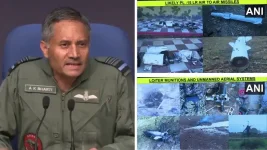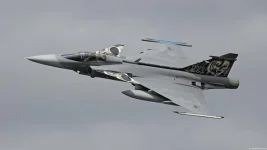India officially confirmed on Monday that its forces had successfully downed a Pakistani Mirage fighter jet during the recent conflict, termed Operation Sindoor.
As evidence, the Indian Army presented video footage displaying the wreckage of the aircraft. Senior defence officials conducted a media briefing detailing Pakistan's unsuccessful aerial attacks and India's effective counter-operations.
Addressing the joint press conference were key military leaders: Director General of Military Operations Lt Gen Rajiv Ghai, Director General Air Operations Air Marshal AK Bharti, and Director General of Naval Operations Vice Admiral AN Pramod. They provided a comprehensive account of the events that transpired under Operation Sindoor.
During the briefing, officials also showcased recovered remnants from Pakistan's failed incursions. This included debris from Turkish-manufactured drones, specifically YIHA and Songar models, as well as fragments identified as parts of a Chinese-origin PL-15 air-to-air missile. These items were presented as tangible proof of the thwarted attacks.
Air Marshal Bharti emphasized the reliability and effectiveness of India's domestically developed defence systems. He specifically praised the performance of the Akash surface-to-air missile system, stating, "Our battle-proven systems stood the test of time. The Akash system performed remarkably." He attributed India’s advanced integrated air defence capabilities to consistent government policy focus and financial backing over the last decade.
The Indian Air Force reported a multi-pronged success during the operation. It successfully intercepted and neutralized all incoming Pakistani missiles and drones aimed at targets across Jammu & Kashmir, Punjab, Rajasthan, and Gujarat.
Concurrently, Indian forces launched precise retaliatory strikes, destroying nine terrorist camps and significant military facilities within Pakistan. Notably, a Chinese-supplied HQ-9 air defence system located in Lahore was among the infrastructure hit.
Officials confirmed that none of the Pakistani projectiles reached their intended destinations within India.
International observers have commented on the operation's outcomes. John Spencer, who holds the position of Chair of Urban Warfare Studies at the Modern War Institute, remarked, "India's domestically produced weapons worked. China’s did not.” Spencer characterized the operation as a clear demonstration of modern military capability and suggested that India's strategic move towards self-sufficiency in defence has established a benchmark for other countries.
This operational success reflects India's significant advancements in indigenous defence manufacturing since 2014, driven by the “Make in India” initiative. For instance, the Indian Army's domestic sourcing for its ammunition requirements has surged from 32% to 88% by 2024.
Several Indian-developed platforms, including the BrahMos supersonic cruise missile, the Pinaka multi-barrel rocket launcher, the Akash air defence system, and counter-drone technologies developed by the Defence Research and Development Organisation (DRDO), have now demonstrated their effectiveness in combat situations.
Operation Sindoor also saw the first combat deployment of Indian-made loitering munitions, often referred to as "suicidal drones," which were ordered in 2021. These were used alongside established assets like the Israeli-origin Harop drones and French Rafale fighter jets armed with advanced SCALP and HAMMER precision missiles.
Reflecting on the nature of modern conflict, Air Marshal Bharti stated, "This was a different kind of warfare.” He added, “If we fight another war, that would be completely different. It is a cat-and-mouse game—we need to stay ahead of the curve.”
Currently, India maintains a formidable air defence network. This integrated grid combines sophisticated systems such as the Russian S-400 Triumf, the Indo-Israeli Barak-8 Medium Range Surface-to-Air Missiles (MR-SAMs), the indigenous Akash systems, and various DRDO-developed anti-drone solutions, creating a comprehensive protective shield against aerial threats.







